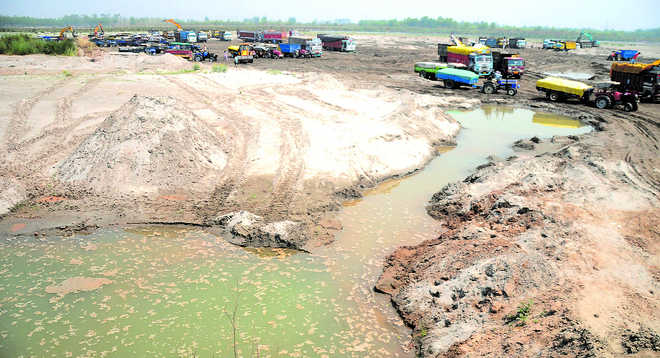
Money mines: Trucks haul sand at a quarry on the Sutlej bank near Mattewara in Ludhiana. From here will start the money-spinning business. Photos: Himanshu mahajan
Manav Mander & Nikhil Bhardwaj in Ludhiana & Ravi Dhaliwal in Pathankot
Go dig up earth in a dry riverbed,” a poor man tells another, as they look up a cloudless sky, as if in prayer, near a river struggling to keep its course, emptying out its wealth to the scorching summer heat. The two had just finished doing exactly that: shoveling sand into the waiting trucks. “Why do we need it?” groans the poor man. “They make houses from it,” grates another. Somewhere else, the sand is being sold — maybe more than Rs 20,000 for a tipper-truck load. “These men are stupid; they don’t work hard enough,” declares an employee of a contractor, ending his nonstory, eager to get his wages, a puny part out of tons of scooped earth near a quarry in Ludhiana.
These and many more such non-stories the trucker drivers share to kill their time, to stay awake, as they ferry sand to open markets of Punjab. The state government last week could not hide its glee after a 2-day e-auction of sand mines netted bids worth Rs 1,026 crore, marking a 20-fold increase in revenue. “The sand is gold, gold is sand,” chirped a state industry department official.
Take a look at the money-spinner: The Punjab government on Friday issued new rules about quarries: if the reserve price of a quarry is Rs 26 lakh, the first bid cannot exceed Rs 36 lakh. In the case of Chaharpur (Amritsar), the bid had jumped from Rs 40 lakh (reserve price Rs 38.26 lakh) to over Rs 1 crore. In most quarries being re-auctioned, the difference between the reserve price and the final accepted bid was over 20-34 times.
Over to Pathankot: The Ravi and Beas leave in their wake the sands of fortune. Three tippers of sand (each costing Rs 20,000, including transportation charges from Pathankot to Gurdaspur), two tippers of gravel (each costing Rs 10,000, including transportation), two tippers of small gravel (each priced at Rs 24,000, meant for flooring) and three tippers of pure Ravi river sand (each costing Rs 18,000, exclusively meant for plastering) are required for a two-storied house. This means that a person will have to spend at least Rs 1.58 lakh just to get the sand and suchlike.
“In 2007, this amount was Rs 50,000. Today, because the old mining rights have expired and the new ones still in the pipeline, little or no mining is going on. This means people will have to wait for a few days to get sand or gravel tippers from quarries,” says real estate dealer of Majha having base in Gurdaspur, Manjit Dala.
The high-quality Ravi-Beas sand is much in demand. People wanting to construct houses in Ludhiana, Jalandhar, Amritsar, Patiala and Bathinda normally buy sand and gravel from Pathankot. “Here the dynamics change. Transportation and toll charges rise as the distance increases. Bringing in mining material from Pathankot to Patiala or Ludhiana means a person will have to spend anything between Rs 2 lakh and Rs 2.5 lakh for a two-storied house. Travelling long distance also means truckers pay bribes to transport department officials and the cops because these trucks are mostly overloaded. Truckers then charge the end-user for these expenses,” says a mining contractor.
Ditto for Ludhiana where the already functional quarry near Mattewara forest reserve, about 22km away. Long queue of trucks, tippers, and tractor trolleys line up around the mining site, waiting for their turn. The site resembles a small town: several private vendors have installed their food and tea stalls for scores of workers.
“Ludhiana’s sand quarries are like goldmines as these have the maximum extraction quantity — over 70 lakh tons annually — in the state,” says a mining official. “The supply is set to outgrow demand, but bidders will not lower the prices because they bought quarries at a higher price. The 13 quarries cleared the auction process at a bid price of around Rs 88 crore,” says the official.
A close aide of a mining firm says 13 quarries are owned by 10 groups in Ludhiana, and it is possible that they would pool together for a monopoly. Once that happens, the sand prices will sure shoot up. “Since there is no fixed MRP, sand can be sold in open markets, where in the absence of competition, huge profits would be made,” the official said.
Badish Jindal, chairman of Federation of Association of Small Industries of India, says there should be a separate department for mining, which is under the department of industries at present. Politicians should be kept away from the business.
“The most worrisome aspect is the absence of a price cap. This is bound to create a shortage and lead to high prices. The least the government should do is fix a maximum sale price to protect those in the construction business or those who are planning to build a house,” says a Kulwant Singh, who runs a construction firm.
“The auction of sand quarries at such a high price is giving sleepless nights to builders and contractors. The construction cost can go up steeply. The business, already at a standstill post demonetization, will get affected further. I am not taking up any new contracts for the time being,” says Harjeet Singh, a private builder.


























